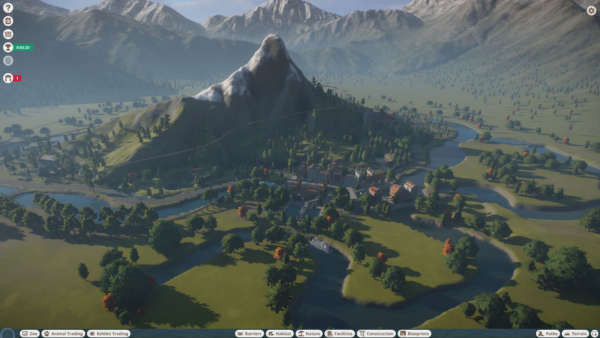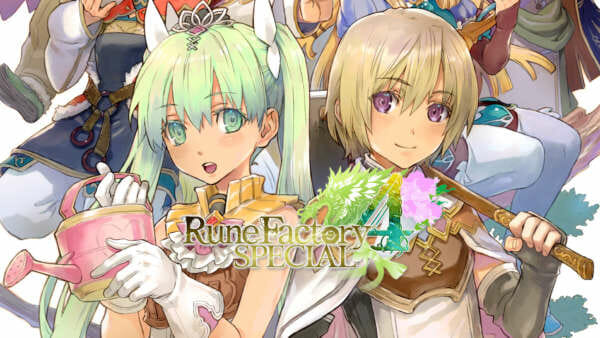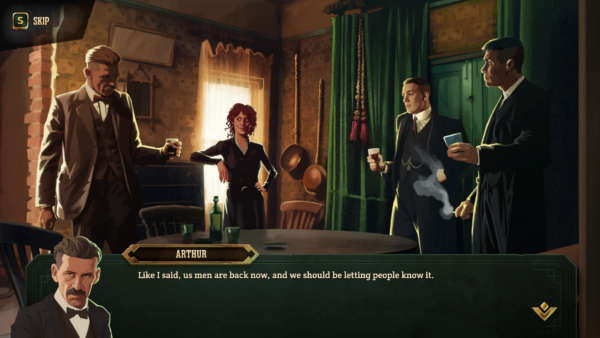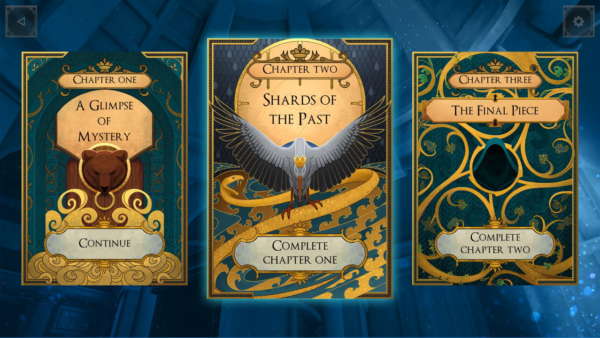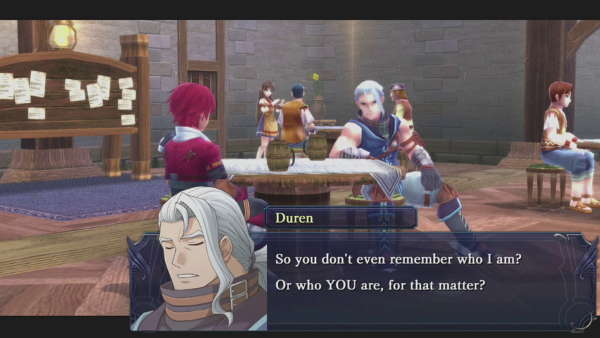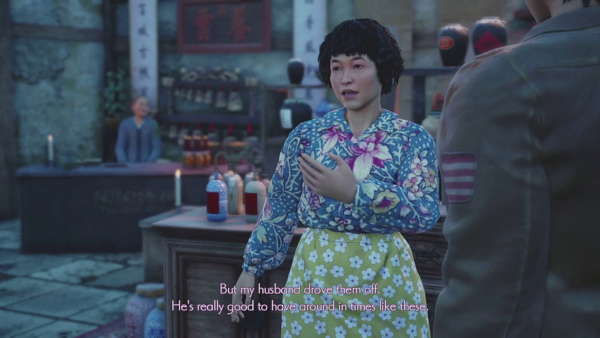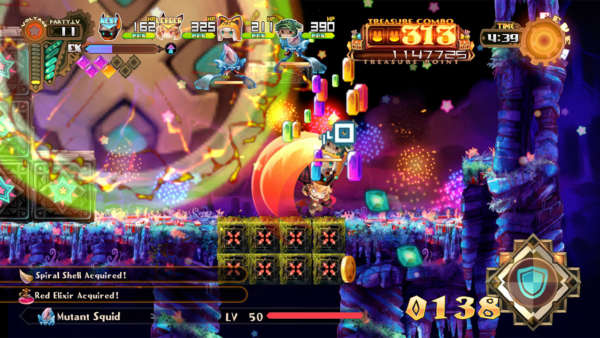Shootmania Storm is brought to you by Mania Planet, the same guys who made Track Mania; which was a nice little social game you could play with friends and not take too seriously. Then all of a sudden Mania Planet decided they wanted to make a competitive eSport and thus created a fast paced mouse-jerker of an fps.
Shootmania Storm is an arena first person shooter in its purest essence. With relatively small maps considering the speeds you can run at and a choice of 2 weapons depending on what game mode you play, the game certainly feels like it was made to divide players by skill and not by what weapon they have.
Opening the game and seeing the home menu you might think you’ve accidently installed a tablet app. With different windows that you swipe between with your mouse the UI for the home menu feels very strange. Another odd thing is you have different buttons for Joust, Elite and Royal mode, even though if you click on the main Shootmania Storm window, all those game modes can come up in there too. As you join the game the first noticeable difference in the UI compared to other FPS games is that there is no gun. There is a reticule crosshair in the middle of the screen which changes style depending on which weapon you are using. The rest of the UI is very bare-bones. A small section at the bottom on the screen will show you your action bar (the amount of action you have left for gliding ect, we’ll get into that later), your rechargeable ammo and how many shields you have left. The score board is very much like all other FPS games, the lack of ping being the only exception. Something different that the Mania Planet games do is colourful names if you can find out the codes you need for the different colours you can have each letter or simple in your name a different colour if you want to that badly.
The controls feel good if not a little clunky at times. Even without mouse acceleration enabled you can’t help feel like your mouse is speeding up as you make a fast turn, and in a game like this you will be making a lot of fast turns. They are the simplest barebones controls for an fps game, with W, A, S and D or arrow keys for movement, spacebar or right mouse click for jump and left mouse click for shoot. This takes a big chunk out of the learning curve for the game as you can pick them up pretty much instantly.
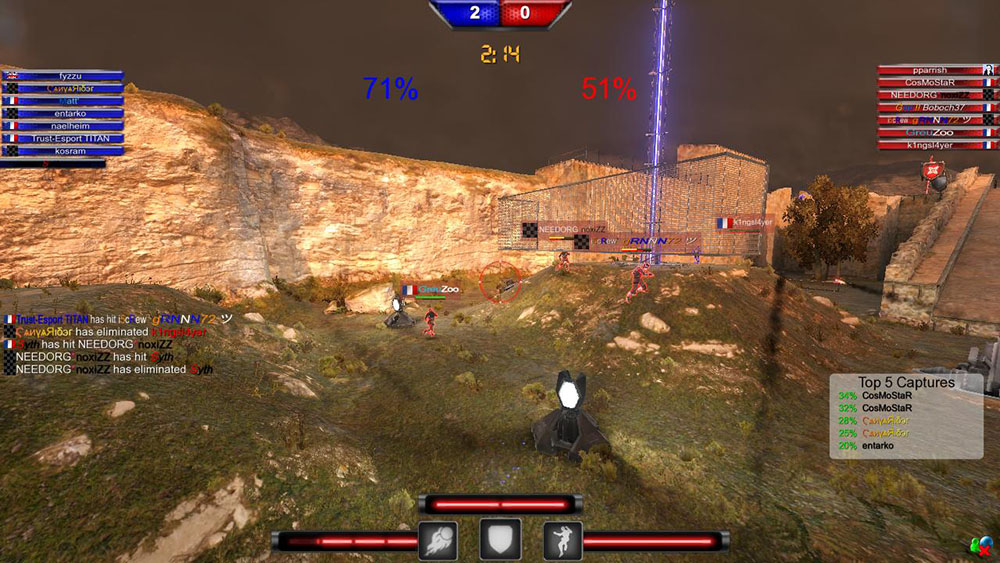
The graphics are okay, nothing special for this day and age but not offensively bad. The simplistic graphics opens the game to more players even on lower ended PCs, the glow of each player makes the characters (which there are only 2 models of) very easy to spot, which is fitting for the futuristic sport feel the game was obviously hoping for. The game has many different game modes to offer, and the game modes are something actually new and refreshing for an FPS game.
In Royal mode the game is a mass of shooting and running in an all on all fight. Each player is given their own colour and has 4 ‘rockets’ that recharge over time as their weapon. Each player takes 2 hits to kill but the weapon takes long enough to recharge that it doesn’t make the 4 rockets to 2 hits feel unfair. The objective of Royal is to either survive the longest while gaining the most points or be the one who controls a middle point on the map. When the middle point is captured the “Off Zone” is activated; this is a spinning vortex of death. No I’m not exaggerating for effect, a stormy vortex around the map slowly gets smaller and engulfs the map towards the centre and if you touch it you die. The winner of this mode is the first person to 200 points so as you can imagine matches can last an extremely long time. This is great game mode for beginners, a simple jump in and go game for anyone not comfortable with higher end play or looking to just have a relaxing game, definitely worth any player giving a go.
Joust is the next game mode and is probably one of the most intense that Shootmania has to offer. Joust is a 1v1 game mode where both players spawn together with 7 hit shields and no ammo. There are 2 poles at each end of the small map, if you get to one you get 5 ammo and then can start fighting, but that pole then becomes inactive and you must get to the other pole to recharge your weapon. However if you do not reach the other pole within one minute of you reaching the first pole, you lose the game. This game mode never fails to give an adrenaline rush, not only do you worry about your opponent at all times and if they have ammo or if it would be wiser to try and stop them recharging, you also have to worry about recharging your own ammo and knowing if your opponent is going to try and stop you, and how much time you have left to get there. Since you both can only have 5 ammo at any time and up to 7 shields depending on if you’re been hit, making your shots count has never been more crucial.
Joust is incredibly fun, the quick and hectic gameplay combined with the strategic thinking is definitely one that can hold your interest for a good while, however waiting for your turn can be boring and frustrating when you’re in the mood to play a fast paced fps. If you’re one of these people who gets their kicks from winning (me being the guilty party here). Joust is probably a “step up” from Royal as a 1v1 scenario with such complicated rules probably isn’t the best jump-in point for new players but for people who have been playing for a decent amount of time.
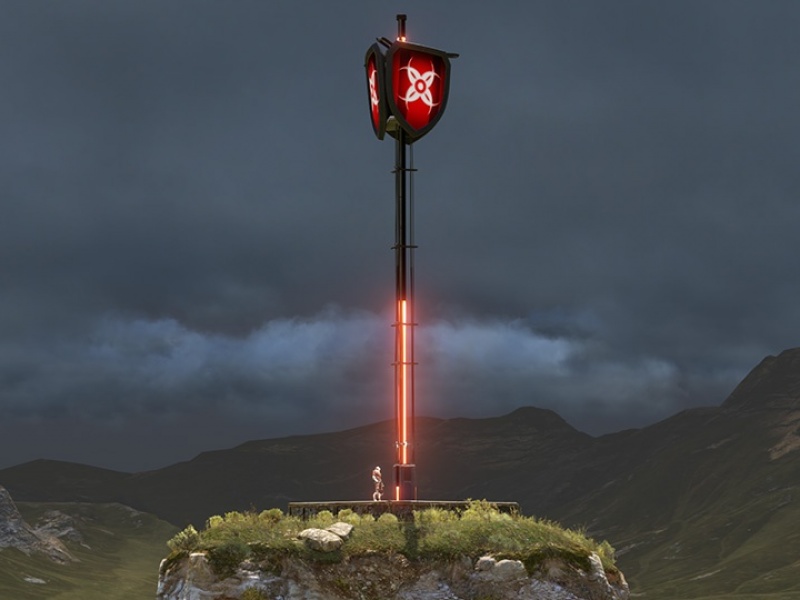
Battle mode is the next mode and moves into team-based play. Each player gets 4 recharging rockets and 2 hit shields. The objective is to capture the enemy’s pole which is located near the enemy spawn; every time you die you re-spawn back at your spawn point near your pole. To capture the pole you must stand on it for 15 seconds without dying but while you’re trying to capture your enemy’s pole, they’ll be trying to capture yours. If at the end of the game neither team has captured the pole, the team with the highest capture percentage towards 15 seconds will win.
Although the rules of battle are simpler to understand, the team aspect of the game-play adds a new dynamic that Joust and Royal haven’t yet. Team play is important to online FPS games as much as all on all play is so to see a game like this implement both and implement them well is a refreshing thing to see from modern day shooters.
Obstacle is pretty self-explanatory. You run an obstacle course in the fastest possible time. The point of the game mode is to have fun competing against people but also improve your movement in the game. One movement mechanic is gliding, after you jump if you hold the jump button you’ll glide for a short amount of time. The glide, like the weapon, will recharge over time so using it at the right time is crucial in competitive play as well as running obstacle courses. Another good movement mechanic for more experienced players is wall jumping. If you jump at a wall and approach it from the right angle and time it right, you can almost vault up the wall or off of the wall to a higher point. This technique takes a while to learn, I myself still haven’t been able to master it and it’s got me killed on many occasions. It’s mechanics like this that really separate skill brackets of a game, but in a good way. Obviously anyone who plays the game socially or just from time to time won’t be able to master these techniques, but players who put effort in and want to improve at the game will reap the benefits of putting time into it. This mode is perfect for learning advanced techniques or just having fun not having to worry about shooting or being shot at, but can become very boring very quickly if running and jumping isn’t your thing.
Siege mode is a lot like battle mode but instead of each team trying to capture the other’s pole, there are attackers and defenders. Over 5 rounds the number of shields for the attackers will increase, so in round 1 the attackers will have 1 shield and so on. Unlike the game modes discussed so far, players can have a choice of weapons to use. The attackers can have the rockets we’ve seen before but also a laser. The laser has one shot but shoots much faster and straighter than the rockets do but also has a longer recharge time so choosing the right moment to use it is important.
The defenders can chose between the rocket launcher or a weapon called the Nucleus. The Nucleus does one point of damage but moves slower than rockets. The up side is that the ball it fires explodes doing area of effect damage and potentially hurting more than one enemy at a time. Again the weapon is situational but effective if a player knows how to use it right. Siege is a great game mode to play with friends, working together to attack or defend a point is a lot more fun with friend than with strangers, the fact that the game mode is so team reliant is good and bad at the same time as communication is key to team victories.
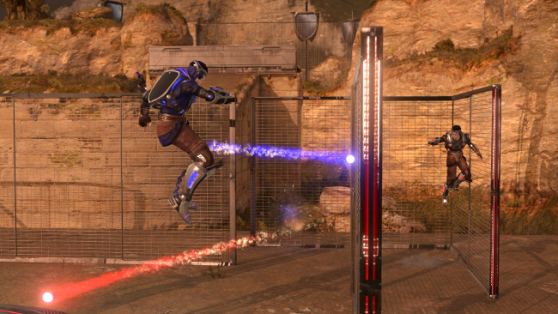
Speed ball is the next game mode and is very much like rugby with guns. A neutral ball spawns in the middle of the map, you have to pick it up and take it to the enemy’s goal, and they’re trying to do the same. The ball can be passed to your team-mates by shooting them so again team play is crucial in winning. If the time runs out and the ball is dropped, the ball resets and a keep-away mode starts where each team tries to keep hold of the ball for 45 seconds in one go and when they do they win the round. This is another great mode to play with friends as communication and team work is so important to win. Speed ball is fun and different giving a game mode not very explored in the fps genre, the team based play again lends itself to be played with friends more than strangers but the option is there to play with new people.
The last major game mode is Elite. For this part of the review I’ll be talking about Shootmania as an eSport more than as a casual game. Elite probably has the most confusing rules of all the game modes. In teams of 3, teams take it in turns to attack or defend a single capture point. The attack team only has 1 player attacking at any time, the attack uses the laser which will insta-kill the defenders who only have 1 hit shield each. The defenders will have a rocket launcher that has 4 rounds but the attackers only have 3 shields. The attack has 45 seconds to eliminate all enemies or capture the point, while the defenders have to protect the point or kill the attacker. Again this game mode is best experienced than explained; but trust me when I say it’s a lot more balanced than it sounds.
Elite mode is the competitive mode played in eSports events. Each player must know their team well enough to know what role they will play in defending the point, but must also have the individual skill to be able to take out 3 enemies alone. I first saw Elite mode being played at an i-Series event and although I was confused for the most part as it was my first time seeing it, it was very thrilling to watch and genuinely gripping at points. This is the mode that separates the casual players from the…well the Elite. A harder game mode with more challenge it is no wonder that it has taken eSports by storm (no pun intended). The game was played in events before it’s official release and I’m sure will have a foothold in them for a long while yet.
Shootmania storm is an FPS for everyone. There are very fun modes for casual players who just want to jump in a game with friends and have a good time all the way up to hardcore Elite modes where people who play to win will give it their all and try and prove that they’re the best. The game is simple and controls well, the control scheme is shown before every single game so you never forget and the lack of game mechanics is almost a blessing on the game as the initial learning curve is very negligible. The game is fun, competitive, exciting and inexpensive. If you are looking for a fun FPS that is finally something different than a modern military shooter, you should check this one out.
